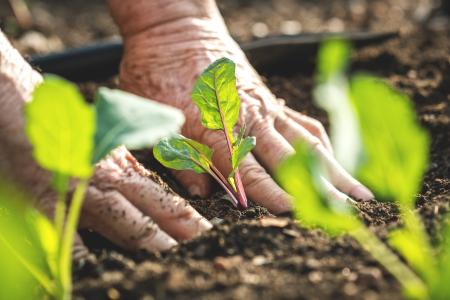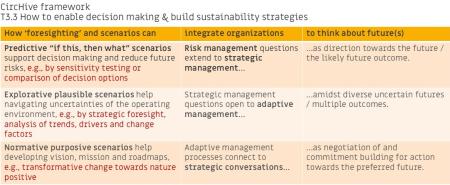
Future is built into the CircHive project in its goal to develop approaches how organizations can recognize, assess and report value of nature and its process to tackle this challenge in collaboration between research and practice.
Future is already here in the choices we make
Targets defined for carbon neutrality and the pathways developed for climate change mitigation vis-à-vis the climate scenarios raise expectations that similar shared directionality could be achieved for halting biodiversity loss. The Kunming-Montreal Global Biodiversity Framework (GBF) set the vision for 2050 and mission toward 2030. Work is ongoing in international forums to develop policy support tools and methodologies, data and knowledge bases as well as modelling of scenarios.
Integrating biodiversity into the assessments is a complex task – not least due to the climate change and biodiversity degradation nexus that scenarios should accommodate. Furthermore, a place-based approach is needed to capture the state of nature and how human actions impact and depend on the ecosystem services provided by nature.
The modelling challenge for biodiversity and ecosystem services provides us an opportunity to rethink how we understand complex systems when it comes to our socio-techno-economic systems, too. What do we include in the analysis, and which factors are considered inside the system and which external as the factors that the system has little or no influence? This is also a time and space dependent question. For example, should we – for the purpose of simplicity – take nature-related physical risks and transition risks as merely exogenous factors for a company managing their resource supply as of today? Or should we think of the complex interdependencies, the direct and indirect implications of company operations that influence on future risks due to biodiversity degradation?
In the CircHive project kick-off meeting in Joensuu in January 2023 a question was raised whether we should focus on impact assessments or, rather, think of tools for transformative change. Instead of thinking this as an either—or question, both perspectives are built within the CircHive project steps toward 2027. Reporting frameworks, certification schemes and standards, financing taxonomies as well as EU policies constitute an evolving landscape, where companies, financing institutions and city administrations navigate. Choices that organizations make today have impact on how future unfolds.
Foresighting and scenario building can enable decision making for several purposes
A framework for what we think about future in CircHive project was presented in a webinar in February 2025 to explicate our view on futures. Futures in plural emphasize that we do not know the future. Instead, we orientate toward future through making outlooks and projections, exploring what could be possible, and defining preferred (or avoidable) futures. Futures thinking makes difference between these perspectives explicit: investigations use several analytical tools, such as different types of scenarios, each for a specific purpose.

In the webinar CircHive project partners shared practical examples of using scenarios. Ivan Paspaldzhiev from EY denkstatt explained what-if scenarios with a company case where the Taskforce on Nature-related Financial Disclosures (TNFD) nature risk scenarios had been utilized to facilitate cross-unit elaboration of risks and their implications for the company. Björn Persson from RISE illustrated normative scenarios with an example of stakeholder engagement in the food system toward sustainable transition, including value creation in networked business model of fossil-free food. Päivi Pelli from EFI discussed how the TNFD scenario analysis builds on explorative scenarios as a starting point, thus, assessing the drivers of alternative developments, and consequently, developing equally plausible narratives how the operating environment could change.
Foresighting is about explorative scenarios. It widens up the radar beyond strategic horizon by drawing attention to trends, drivers, change factors and signals of change. Discussion in the webinar demonstrated that it is easier to think of the predictive what-if scenarios and normative preferred scenarios. Most challenging is to work with the openness in exploring implications of alternative futures without rushing into probabilities or preferred outcomes.
IPBES methodological assessment report on scenarios and models of biodiversity and ecosystem services depicts that different types of scenarios all play a role in a policy cycle. An analogy can be drawn for strategy cycles of an organization: 1) In the envisioning phase, explorative scenarios are needed to open accustomed assumptions about the future. 2) In defining the direction and setting targets, normative scenarios are needed to build commitment and shared understanding on the way ahead. 3) In choosing optimal action for implementation, predictive what-if scenarios are needed to compare alternative action choices. And 4) in performance assessment for possible strategy/policy adaptation or change, all scenario types can be used.
Futures thinking is a mindset change from either—or to both—and
The CircHive webinar illustrated that investigating futures builds on interaction. Predictive scenarios simplify real-life systems with ceteris-paribus assumptions, i.e., one or few factors change, others remain the same. Yet, facilitated discussions on future scenarios help to identify blind spots of risks/opportunities within the extant business models. Economic consequences of nature-related risks, even if they were rough approximations, are crucial in communicating the scenario exercise to decision/policy making. Quantification of risks and opportunities, however, is necessarily time bound. Long-term assessments always include uncertainties which can be tackled only by preparing for many plausible scenarios, and getting people or other organizations committed to action. Transformative future requires imagination of new futures where rules of the game have changed, that is backcasting rather than forecasting.
Building capacities in futures thinking and foresight is a mindset change. It means changes in the processes of individual organizations, groups of organizations and communities of professionals. Future cannot be assessed as evidence. Information about future is composition of past facts, constructed ideas and perceptions. Although we can influence the future, we should not set our minds on the foreseeable or preferred outcomes only.
The framework for what we think about future in CircHive project provides a structure for our next steps. The idea with foresighting and scenario building task is to identify how biodiversity can be better integrated into decision making and sustainability strategies, but also to identify entirely new sustainable business models.
Want to learn more? – follow up our capacity building events. Capacity building webinars are to share expertise and experience in BEEHive, share information but also discuss the opportunities and challenges ahead.
This article was written by Päivi Pelli [ paivi.pelli @ efi.int]